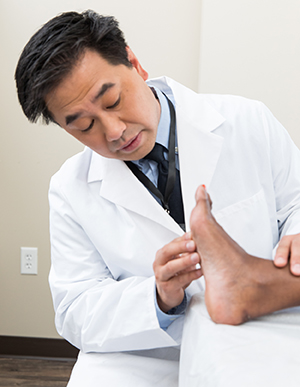A
B
C
D
E
F
G
H
I
J
K
L
M
N
O
P
Q
R
S
T
U
V
W
X
Y
Z
Click a letter to see a list of conditions beginning with that letter.
Click 'Topic Index' to return to the index for the current topic.
Click 'Library Index' to return to the listing of all topics.
Diabetes: Treating Minor Foot Infections
Diabetes makes it harder for the body to heal. Diabetes can also cause nerve damage. This means you might not feel a sore on your foot. Even minor foot problems, like a blister, can become infected. If not treated, infections can spread and damage nearby tissues. You may need treatment in the hospital. Serious infections can result in loss of a toe or foot. Quick care by your healthcare provider can help clear up infections and prevent serious problems.

Get treatment
If your healthcare provider finds a minor foot infection, you’ll be started on treatment. The goal is to heal the infected area. And to prevent spread of the infection. Follow all treatment directions from your healthcare team.
-
Your provider will check and clean the infected part.
-
They will measure the length, width, and depth of the infected area. That way, your wound care team can tell if the wound is healing or getting larger from one visit to the next.
-
Your provider may give you antibiotics to fight the infection. Take your antibiotic as directed on the bottle. Take all the medicines you are given, even if the sore starts to look better. If you don’t, the infection will not go away and may spread.
-
Your provider may change your diabetes medicines to better control your blood sugar.
-
You may be asked to keep the infected area dry.
-
You may be told to keep your feet raised or to limit walking. Swelling of the foot with fluid can slow wound healing. You may also be fitted with a cast or another type of special shoe to take the pressure off the injured area.
-
Follow any directions you are given about changing bandages. Some dressings or gels include special antimicrobial products and growth factors to help the wound heal.
Follow-up care
When you have diabetes, a foot infection may take a long time to heal. That may even be the case if you take antibiotics or have other treatments. For best results, be sure to keep all your follow-up visits with your healthcare provider. They can then make sure you’re healing the right way.
When to call your healthcare provider
Check your feet every day. Use a mirror to look at the bottoms. Also check between your toes. Call your healthcare provider right away if you have any open or infected areas on your feet. You might be able to take a picture of the open area with your smartphone to send to your provider. Watch for these signs of an infection:
Also call your healthcare provider if any of the following occur:
-
Corns, calluses, sores, cuts, blisters, or bunions on your feet
-
Swelling of feet or legs
-
An ingrown toenail
-
Itching or cracking between your toes
-
Constantly cold feet
-
Pain or cramps in your legs or feet while walking
-
Changes in skin color
Online Medical Reviewer:
Jessica Gotwals BSN MPH
Online Medical Reviewer:
Rita Sather RN
Online Medical Reviewer:
Robert Hurd MD
Date Last Reviewed:
7/1/2022
© 2000-2024 The StayWell Company, LLC. All rights reserved. This information is not intended as a substitute for professional medical care. Always follow your healthcare professional's instructions.